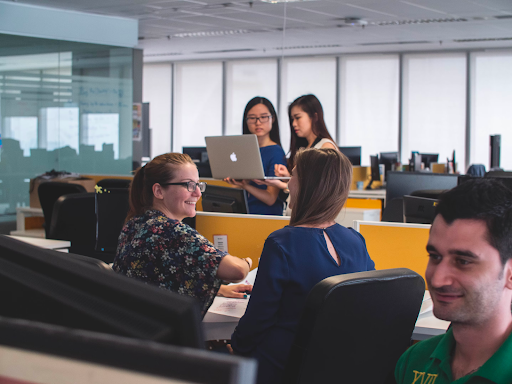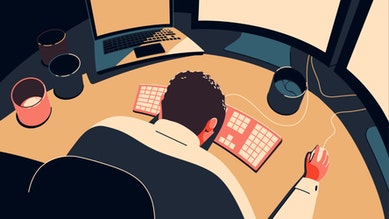People have experienced unprecedented times when it comes to work, in particular remote working and the isolation that can bring. We are not experiencing the interaction and emotional connection we would normally share with colleagues on a daily basis. Small talk is an integral part of office culture, from conversations geared around how our weekend went, the fact that Sandra’s child has started ballet classes or even the shenanigans of the office party.
Now hybrid working is the norm, we have realised the need for a healthy blend of interacting with colleagues and quiet time in the office, as it is essential for the overall happiness and wellbeing of staff and humans in general. It is very important for the office to have a good atmosphere for optimal productivity levels.
We have therefore carried out a survey that questioned 1,000 UK office workers aged 18 and over. The research focused on where they catch up with their colleagues, the types of favours asked of them, how many print personal documents and if they are aware of the difference between ink and toner.
Where do workers catch up with colleagues?
Our survey revealed the top six areas of the office workers prefer to catch up with their colleagues: the first area is at their desk at 50%, at their co-worker's desk at 29%, in the kitchen at 29%, in the canteen at 19%, 12% at the printer or scanner and finally 8% at the water cooler.
Among all of the age groups, workers aged 45 to 54 prefer to catch up at their desk, demonstrating the greatest percentage, at 53%. The 18 to 24 year olds prefer to catch up at their co-worker's desk the second most at 38%. And the 25 to 34 year olds prefer the office kitchen, at 36%.
We looked into where office workers choose to speak the most to their co-workers according to the nearest city they work in.
The cities where workers are most likely to catch up at their colleagues' desks are Worcester at 64%, Wolverhampton at 55% and Gloucester at 42%.
And the cities where workers are most likely to have a catch-up in the office kitchen are all in Wales: Swansea at 56%, Aberystwyth at 50% and Cardiff at 45%.
The cities where workers are most likely to speak to each other in the canteen were Aberystwyth at 50%, Brighton at 40% and Sheffield at 30%.
Lastly, the cities where workers are most likely to have a chat with their co-workers near the water cooler were Aberdeen at 25%, Brighton at 23% and Swansea at 22%.
What favours do workers ask their colleagues?
We delved into the top five favours that office workers ask of their colleagues and found that 25% ask their colleagues to make a cup of tea or coffee, print something off for them at 19%, wait for them to take a lunch break at 18%, help them with their printer settings at 16% and finally request a lift home at 11%. Overall over a third (35%) ask printer related questions.
We explored what favours people asked most of their co-workers in terms of age. 18 to 24 year olds are most likely to be asked by a colleague to make a cup of tea or coffee at 38%. They are also the most likely to be asked by their colleagues to print something off for them at 36% and be asked by workmates to wait for them to take a lunch break (41%).
We also discovered what favours workers were most likely to ask according to their nearest city. In Cardiff, 52% answered that they are asked to make a cup of tea or coffee, with 43% in Liverpool and 33% in both Swansea and Wrexham. The people in the cities that were most likely to ask their colleagues to print something off for them were Aberystwyth at 50%, Swansea at 33% and Chelmsford at 30%. The cities that were most likely to ask someone to wait for them for lunch break were Newcastle at 33%, Oxford at 32% and finally Aberdeen and Brighton at 29% each.
Printing personal documents at work
Our survey revealed that 77% of office workers admit to printing their personal documents at work.
In more detail, 6% of office workers print their personal paperwork all the time with the office printer, 17% print personal paperwork often, 28% print personal paperwork sometimes and 26% rarely print personal documents. Only 16% said they never use the office printer for personal use.
18 to 24 year olds are most likely to use the office printer for personal use, as 15% in this age group stated they use the office printer for their own documents all the time and a whopping 38% answered they do it often. The over 65 age group are the most conscientious with 33% stating they never print their own documents using the office printer.
The cities where the most people answered that they use the office printer for personal use are Oxford at 25%, Chelmsford at 23% and Swansea at 11%. And the cities least likely to use the office printer for personal use are Aberystwyth at 50%, Wrexham at 44% and Portsmouth at 36%.
The difference between ink and toner
We then looked into whether office workers know the difference between ink and toner. Simply put, ink is wet and toner is dry. This is because during the toner-based printing process, the dry toner is pressed and fused onto the paper, which means that it is quite literally soaked into the page.
But do office workers know the difference?
On average only 36% of UK office workers knew the difference between ink and toner, while 29% admitted that they weren’t sure.
In terms of age group, over 65s were most likely to be aware of the difference between ink and toner with 48% being correct, whereas the 25 to 34 age group were the least likely with just 30% knowing the answer.
Additionally, men were more likely than women to know the difference between ink and toner; 43% of men were correct compared to 29% of women. However, women were twice as likely to admit they didn’t know the difference at 38% compared to just 19% of men.
The top five cities to be correct about the difference between ink and toner were:
- Newcastle (59%)
- Portsmouth / Wolverhampton (55%)
- Birmingham (52%)
- Southampton / Leeds (49%)
- Edinburgh (47%)
Conversely, the top five cities to admit that they didn’t know the difference between ink and toner were Wrexham at 67%, Gloucester at 58%, Norwich at 55%, Plymouth at 52% and finally York at 44%.
Our biggest takeaways
Our survey revealed the top six areas of the office workers prefer to catch up with their colleagues are their desk, their co-workers’ desk, in the office kitchen, in the canteen, at the printer or scanner and finally at the water cooler.
The top five favours that office workers ask of their colleagues were to make them a cup of tea or coffee, print something off for them, wait for them to take a lunch break, help them with their printer settings and finally request a lift home.
Our survey also revealed that a whopping 77% of office workers admit to printing their personal documents at work, with the largest percentage admitting to sometimes printing personal paperwork at their place of work.
On average our survey found that only 36% of UK office workers are aware of the difference between ink and toner.
Over 65s were the age group that was most likely to be aware of the difference between ink and toner and more men than women know the difference.
Finally, we discovered that the city most likely to be correct about the difference between ink and toner was Newcastle.
What will 2022 bring for office chat?
Due to the pandemic and over a year of interacting with colleagues and clients through a computer screen, many people are worried about returning to the office and chatting with their colleagues once again.
With new variants of Covid being discovered constantly such as Delta and now Omicron, it is difficult to predict what 2022 will bring for office chat and therefore plans are tentative.
What does seem likely is that “hybrid working” may become the new norm. It is defined as working partly in the office and partly remotely, in most cases two to three days a week.
This will hopefully mean that office workers can once again interact face-to-face with their colleagues because there’s nothing like a catch-up to start the day. It also contributes to employees' positive emotions and promotes their wellbeing.

